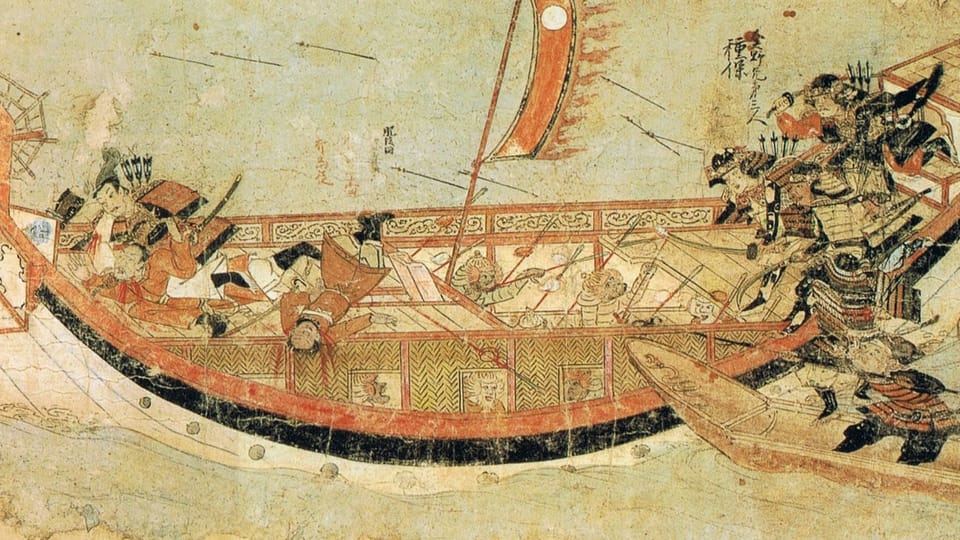The Samurai of the Kamakura Period: A Defining Era of Warriors

Today we’re diving into some serious samurai history, and trust me, this one’s got layers. We’re talking about the Kamakura period (1185–1333), a time when the samurai weren’t just sword-swinging badasses—they were running the show. And why’s this era so damn important? Because VIKINGS vs SAMURAI lands smack dab in the middle of it. See, the Viking Age ended around 1050, so for me to make the Viking-samurai showdown legit, I had to get creative. I cooked up this whole counterfactual history where King Cnut and Henry III team up to stretch the Viking Age longer than it actually lasted. Yeah, I know—it’s pretty genius. But hey, even I needed to brush up on my Kamakura samurai knowledge, so let’s break it down.
Origins of the Kamakura Period
Japan is in chaos. Two big-time clans, the Taira and the Minamoto, go head-to-head in the Genpei War (1180–1185). It’s a bloodbath. By the end, the Minamoto, led by the OG samurai boss Minamoto no Yoritomo, wiped out the competition and seized power. Yoritomo rolls into Kamakura and sets up shop, creating Japan’s first shogunate. This is huge. It’s the first time power shifts from the emperor and those fancy court nobles to a straight-up warrior class.
The samurai are now more than swords-for-hire—they’re the new aristocracy. Yoritomo’s political setup means these guys don’t just fight; they run things. They govern land, collect taxes, and, most importantly, stay loyal to the shogun. The Kamakura system? It locks the samurai into power for the long haul.
Samurai Code and Bushido Origins
Now, let’s get into the meat of samurai ethics. The Kamakura period is where the DNA of Bushido (the “way of the warrior”) starts to form, though it’s not the code we know today. Back then, it wasn’t some neat little handbook of samurai rules—it was more like a collection of unspoken values. Loyalty to your lord? Check. Fearless in the face of death? Double check. Courage, discipline, honor? These were the currency of a samurai’s soul.
And don’t forget Zen Buddhism’s influence. This wasn’t your typical “sit under a tree and meditate” philosophy—it was grit. Zen taught the samurai how to control their minds, stay focused, and be totally at peace with death. They weren’t just warriors, man; they were warriors with inner calm. The zen mindset and samurai ferocity? A lethal combo.
Armor and Weapons
Kamakura-era samurai didn’t mess around with flimsy armor. These dudes wore ō-yoroi—boxy, layered plates of iron or lacquered leather designed for mounted archers. Yeah, they looked like walking tanks, but they needed that protection. Their helmets, the kabuto, were decked out with wild crests, making each samurai stand out like rockstars on the battlefield.
And the sword? Well, forget the iconic katana for a minute. In the Kamakura period, the tachi was where it was at. These were long, curved blades perfect for slicing down enemies on horseback. But the real MVP? The yumi, the longbow. These guys were expert archers, first and foremost, raining arrows down from horseback before charging in to finish the job up close.
Role in Society
Let’s talk power. With the Kamakura shogunate in charge, samurai weren’t just soldiers—they were landowners, rulers, and the law. Before this era, the imperial court called the shots, and the samurai were just the muscle. But now? Samurai run the local show. Yoritomo’s decentralized system meant the samurai had to govern their territories, enforce laws, and defend their land like mini-kings. It was feudal Japan, baby.
But here’s the twist: even though they had power, samurai weren’t into flashy displays of wealth. Being too extravagant was seen as dishonorable. The Kamakura wars bred a culture of discipline—samurai lived for battle, for duty, and for their lords. The more hardcore and stoic they were, the better.
Mongol Invasions: Samurai Tested
Then came the Mongols. In 1274 and again in 1281, Kublai Khan sent his fleets to Japan, and man, did they come in hot—new weapons, gunpowder bombs, and tactics the samurai had never seen before. The samurai, used to individual combat and archery, faced massed Mongol infantry and relentless attacks. It was chaos, but the samurai didn’t back down. They adapted, fought like hell, and, spoiler alert, Japan didn’t fall.
The Mongols got wrecked by a little something called kamikaze, or divine winds—typhoons that wiped out the invading fleets. Still, the battles were brutal, and they took a toll. Defending Japan solidified the samurai’s status, but the costs? Huge. Financially, it drained the Kamakura shogunate.
Decline of the Kamakura Shogunate
And here’s where things start to fall apart. See, after the Mongol invasions, the Kamakura shogunate couldn’t exactly reward the samurai who fought to protect Japan. There was no land to give out—because, you know, they didn’t conquer anything. So the samurai were pissed, feeling unappreciated and underpaid. That dissatisfaction? It festered.
Add to that the power-hungry Hōjō clan (the guys running the shogunate behind the scenes) and the whole system’s unraveling by the early 14th century. In 1333, Emperor Go-Daigo leads a rebellion and takes the shogunate down. The Kamakura period is over, and the Ashikaga shogunate rises. But, man, the damage was done.
Legacy of the Kamakura Samurai
Here’s the kicker: even though the Kamakura shogunate fell, the samurai’s warrior culture was here to stay. This era built the foundation for the Bushido code that would later be formalized. The loyalty, discipline, and stoic approach to life and death that characterized the Kamakura samurai would echo through the centuries, right up to the Edo period and beyond.
Zen Buddhism’s influence stuck around too—samurai weren’t just brutes with swords, they were warriors who embraced both the calm and the storm. They shaped Japan’s identity, ruling over a decentralized society built on feudal loyalty, martial prowess, and a whole lot of grit.
In the end, the Kamakura samurai didn’t just swing swords—they built the warrior ethos that defined a nation.
